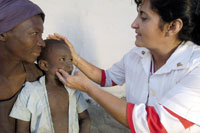Why hospitals and patients are sick
By
Sharon Eolis, N.P.
New York
Published Apr 20, 2005 4:10 PM
Imagine going to the
hospital for an operation and being told the surgery was canceled and you need
to reschedule.
With many hospitals in deep financial trouble, there is a
good chance of such a postponement, often due to the lack of a piece of
equipment for an orthopedic procedure or some other necessary device. Many
hospitals are over-extended and in debt to the companies that equip and supply
them, which will provide the materials only after they receive payment from the
hospital.
In New York state, as elsewhere, the hospital business
represents a very large section of the economy. And the hospital industry here
owes $15 billion in outstanding long-term debt. (New York Times, April 11) Many
of the most prestigious teaching hospitals in Manhattan, like Mt. Sinai and St.
Vincent’s, as well as nearby Westchester Medical Center, have been
operating in the red over the past five years, to the point of
“hemorrhaging money.”
In the past 15 years, 20,000 beds have
been lost in the state. A dozen hospitals have closed over the past two years
and another dozen are at risk.
In this period many technological advances
have impacted on health care, from new drugs to treat infections to laser
equipment that allows smaller surgical inci sions so people can go home shortly
after surgery. In the 1990s a new class of anti-viral drugs was produced, making
it possible for thousands of people with HIV-AIDS to be treated in outpatient
clinics rather then spending weeks in the hospital. All these changes decreased
the need and length of stay for thousands of patients.
Several factors
contribute to the present crisis. Health maintenance organizations (HMOs), which
are turning enormous profits, have taken the hospitals to the cleaners by
negotiating rates that do not cover the actual cost for procedures and hospital
admissions. They have also pressured hospitals to shorten the time they keep
patients.
Another cause for lost revenues is that millions of people have
no health insurance. Their only access to health care is to go to emergency
rooms. If they have serious conditions, they may require admission to a
hospital.
In 1997 New York Gov. George Pataki got rid of price-setting
laws that protected the hospitals. The rise in managed care organizations
squeezed the hospitals nationally. New York, already in debt, was harder hit
than other parts of the country.
Kenneth E. Raske, president of the
Greater New York Hospital Association, says: ”These HMOs have eaten the
hospitals’ lunch. They have made obscene profits by strip-mining
communities.”
In the 1990s a “medical arms race” began
in New York with hospitals rushing to get in on high-profit businesses. They
began opening cardiac centers, orthopedic surgery centers and cancer centers.
With many institutions vying for patients, there was often saturation of the
market—
capitalist overproduction—and these pro jects then lost
money. The state had some respon sibility because it approved the
projects.
Perhaps one of the biggest changes to affect the national
health-care system is in federal aid policies.
The federal government has
spent billions of dollars on the invasion and occupation of Iraq—at the
expense of the people in the U.S. There have been draconian cuts in Medicare,
Medicaid, Aid to Families with Dependent Children, food stamps, family planning,
pre-natal care and Ryan White funds. Those hardest hit are poor and working
people in the oppressed communities. Meanwhile the U.S. government is spending
$10 million per hour for the wars in Iraq and Afghanistan.
This money
brings death and destruction to the people of Iraq and to the U.S. troops, who
are into extended terms of duty. Since the first Gulf War, GIs have been
complaining about a variety of illness called Gulf Syndrome. In the second Iraq
war the troops have had extended exposure to depleted uranium and are coming
back with multiple health problems. The federal government is nevertheless
closing down Veterans Administration hospitals, even though some returning
veterans have to wait up to a year to be seen.
Need for universal
health care
|
A Hatian boy is examined by
by Magdalena Mauri Gomez,
one of more than 500 Cuban health
care professionals serving in Haiti.
|
All this amounts to an urgent need for a universal
health-care system that plans for people’s needs, not corporate greed and
profits. A system that provides free, quality health care to all the
people—disabled, seniors, immigrants, people of color, infants and
children, straight or gay—from the cradle to the grave. A system based on
socialist planning.
Such a national health program would provide health
care to all sectors of the country, urban and rural. It would train a variety of
health care providers at government expense so there would be enough health
workers to take care of the people.
Cuba has a socialist health-care
system that meets the basic needs of all the people even though it was developed
with limited resources—a consequence of the 45-year-old U.S. blockade. In
fact, the Cuban system is world-famous for having radically reduced infant
mortality and for producing new vaccines for meningitis and hepatitis before any
other country. Pre sently the Cubans are working on developing vaccines for
cancer and HIV-AIDS.
The small island of Cuba has provided thousands of
doctors and nurses to countries hit by natural disasters and has helped develop
health care programs in many countries in Latin America and Africa. The Cuban
example in the health-care field is an example for the world
today.
Eolis is a nurse practitioner in New York
City.
Articles copyright 1995-2012 Workers World.
Verbatim copying and distribution of this entire article is permitted in any medium without royalty provided this notice is preserved.
Workers World, 55 W. 17 St., NY, NY 10011
Email:
[email protected]
Subscribe
[email protected]
Support independent news
DONATE


